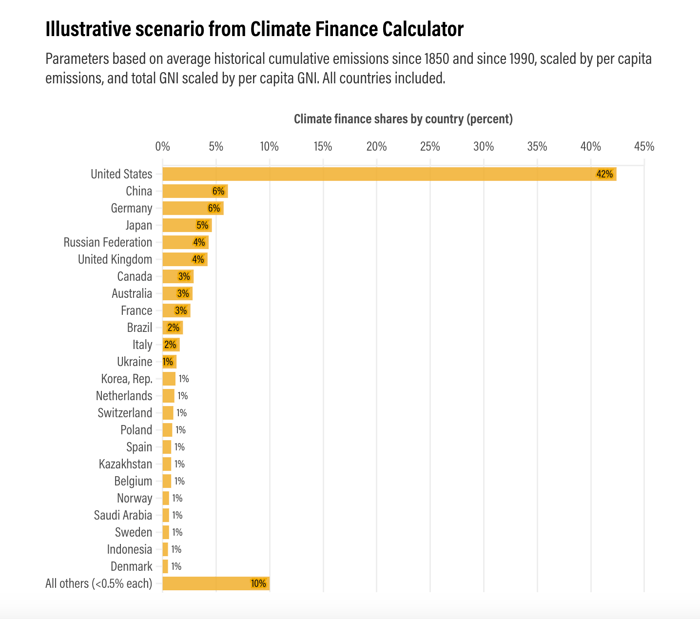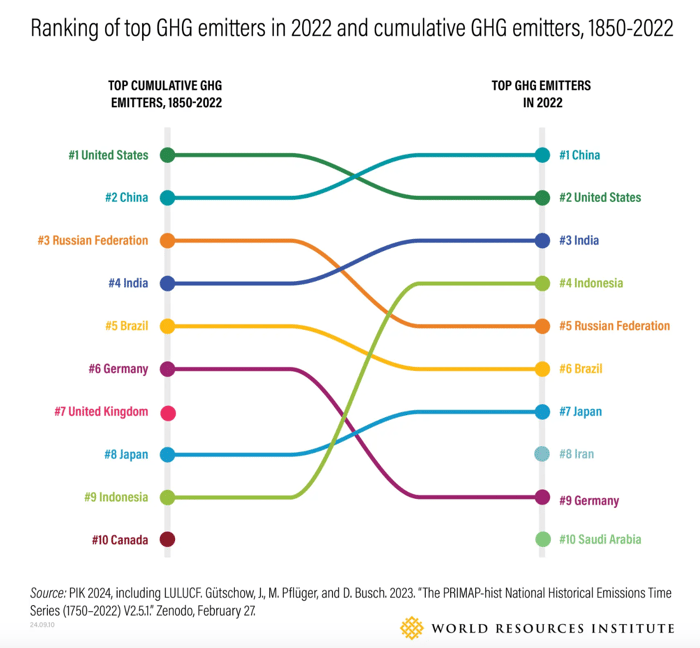Almost every scenario combining emissions and economic metrics ascribes the greatest responsibility to provide climate finance to the United States.


Photo credit: Karsten Wurth
As already reported ahead of the COP29 last November it is crucial for all countries not to lose sight of the need to fight climate change - independent form geopolitical sea changes, pushbacks, backlashes or other developments. The direction of travel of international organisations, companies and governments should be guided by evidence, science and facts.
Research conducted by the World Resources Institute (WRI) addresses the question of global responsibility for the negative effects of climate change. One of the tools used to provide an overview on the current state is the climate finance calculator which integrates historic emissions and countries' income levels among other factors.
Cumulatively, the U.S. is the source of more greenhouse gas emissions since the 1850s than any other country, and it remains the second-largest emitter on an annual basis as well. The U.S. is also the biggest economy in the world. This is not simply because it’s a large country — the nation also has high per capita income and emissions levels (WRI)
<br><br>
For example, a scenario that combines data for per capita and cumulative emissions (from 1850) with data for per capita and total gross national income (GNI) converted to international dollars using purchasing power parity rates (see methodology here), it can be seen that the U.S. is responsible for a much higher amount of finance than any other nation, with China in a distant second place. Using cumulative emissions data starting from 1990 still puts the U.S. on the top of the list, though with a smaller margin.

The WRI also refers to the need to consider more recent data and economic development.

However, China’s per capita emissions are still 4 times less than those of the U.S. Meanwhile, some smaller countries now have higher per capita income and/or emissions higher than the U.S. (WRI)<br>While the data doesn't provide unequivocal answers as to who should provide international climate finance, low-income, low-emitting countries have no role to play as contributors in any scenario. (WRI)<br>
The research from WRI suggests that combining metrics for per capita and cumulative for both GNI and emissions gives the most reasonable result when considering potential changes to the current climate finance contributor list. Looking just at one such metric on its own can provide skewed results.
WRI also refers to the challenge to consider past and recent economic growth: The answer to the question of how to divide responsibility could also come down to factors that can’t be as easily captured through comparisons of emissions and income. For example, there are differing views on how to compare economic development, with many who, from a fairness perspective, see nations that have enjoyed recent rapid economic ascent as different from those that have enjoyed a higher economic status for a longer time period.
There is also the issue of climate vulnerability. Some nations — some small-island developing states, for example — are financially well off and have high per capita emissions. Yet they also face existential threats from climate impacts. Should these countries be on the hook for some international climate finance? Most would likely say no, pointing to the significant and disproportionate domestic financial needs they now face, due to climate change. (WRI)
For more information on climate finance pledges, funding goals and targets refer to WRI resources and articles.
Published by
 investESG
investESG
 investESG
investESG

